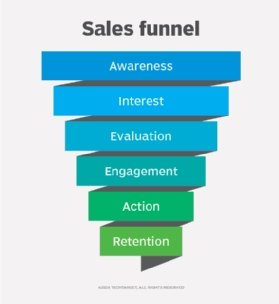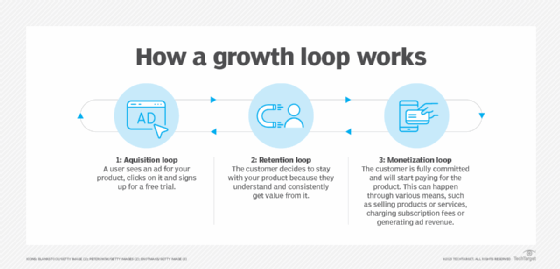
Getty Images/iStockphoto
How product-led growth can help scale your business
With a product-led growth strategy, you can take the pressure off your sales and marketing teams and center what really matters: the product and the customer.
In the modern digital landscape, product-led growth has emerged as a powerful and efficient growth strategy that aligns with customers' preferences and expectations.
Product-led growth (PLG) centers the product as the primary driver for customer acquisition, engagement, retention and expansion. In a PLG strategy, the product itself is designed to be intuitive, user-friendly and valuable, enabling users to easily adopt and get value from it without extensive effort from sales and marketing teams.
PLG often leads to lower customer acquisition costs, faster adoption rates, higher user engagement and increased customer loyalty. It enables users to experience the product's value firsthand, so it fosters a self-sustaining cycle where satisfied customers become advocates and drive organic growth through referrals and word-of-mouth.
However, PLG has made sales and marketing teams wonder if their roles will become obsolete. In short, no -- they aren't going anywhere. Marketers still hold the key to attracting users while sales reps amplify monthly recurring revenue. However, you should use PLG alongside existing efforts to gain a competitive edge in the market.
Growth isn't sequential
When you find product-market fit, you should distribute your product or service in a cost-effective way to grow your business. This process is known as the sales funnel. However, growth is only possible if you can help customers efficiently navigate their journeys through the funnel. If you can't drive product growth, it doesn't matter how good the offering is.
Marketing, product, sales, customer success and other teams are all involved in product distribution. Each team's success metrics are typically aligned but might be negligible unless they can all produce conversions. For example, if the marketing team launches a campaign that produces a 60% conversion rate on demo requests and sales can't convert them, it creates a bottleneck.

Further, this model requires a constant and increasing flow of potential users to function. You must acquire, retain and monetize your customer base. However, generating revenue, activating and retaining customers, and getting referrals creates silos within an organization. Product distribution also looks different per product.
Further, the sales funnel doesn't fully account for the rapid consumerization of B2B software. Most buyers prefer a seller-free sales experience, so you need a digital-first approach to meet their preferences and convert them. CX and high product quality must also be a priority, rather than using sales and marketing as the primary lever of growth.
Sales funnels vs. growth loops
The linear sales funnel is a traditional approach to sales and marketing. It represents a step-by-step process detailing customers' actions, ideally leading to conversions, which produce more revenue over a customer's lifetime than acquisition. The sales funnel assumes that customer acquisition is an event, not a process. The funnel is a natural visual aid since the number of potential customers decreases as they move toward the final conversion stage, with only a fraction making a purchase.
The growth loop is a cyclical approach that recognizes how customer acquisition, retention and monetization are interconnected and ongoing processes. Growth loops account for the fact that one customer's actions lead to more customers, creating a self-reinforcing cycle. They use customer behavior, network effects and referrals, and focus on creating a continuous and expanding user base.
In essence, growth loops are part of the broader PLG framework and showcase how the product can organically drive growth with user behavior and network effects. It removes the individual responsibility of a specific team for one or two stages of the customer journey and, instead, requires each to play a role at every stage. The motion, or flow, of PLG is circular.

4 benefits of a PLG strategy
PLG enables companies to scale faster and they are more likely to grow year-over-year than sales-led models.
1. Lower customer acquisition costs
PLG companies typically see lower customer acquisition costs because they center their strategies around product-driven experiences to drive conversions. Existing users drive more revenue, which decreases the costs and resources needed for customer acquisition efforts. Companies that use PLG often see a higher percentage of leads from referrals and organic searches.
2. Higher net dollar retention
Net dollar retention (NDR) takes the rate of expansion and subtracts revenue reductions and customer churn. Strong NDR signifies the company can successfully retain existing customers, as well as upsell and expand customer relationships.
3. Faster sales cycles
Product-led companies have faster sales cycles than companies with traditional sales models because users can sign up for and start using the product immediately. This accessibility expedites the decision-making process and eliminates the need for prolonged sales efforts.
4. Data-driven decision-making
Most product-led companies use UX data to develop product roadmaps. They can make data-driven decisions about their strategies with a wealth of user behavior data, which they can to identify areas for improvement and growth.
How a PLG strategy benefitted Slack
Holly Chen formerly led digital marketing at Slack and helped the company grow from 3 million to 12 million daily active users (DAUs). I asked her to weigh in on how she used PLG during her time at Slack.
"PLG enabled Slack to have fewer employees per product, quick buying decision-making and no handholding of the team. This improves operating costs, leading to increased margins per customer," Chen said.
Slack's PLG approach enabled it to acquire many users with lower customer acquisition costs, a shorter sales cycle and higher conversion rates when upgrading to higher tier and enterprise plans. Having a PLG strategy also enabled companies like Miro, Loom and Zoom to capitalize on the pandemic boom.
The future of PLG
PLG might become the dominant go-to-market strategy for B2B SaaS companies. It is disrupting the way vendors sell software. Product-led strategies are becoming increasingly effective due to advances in AI and machine learning (ML).
Businesses can use AI and ML to personalize CX, identify and fix usability issues, and predict churn. We can expect to see new tools and technologies emerge that are specifically designed to help companies implement and execute PLG strategies. PLG is currently most popular in the SaaS industry, but it has the potential to be successful in various other industries, as well.
About the author
Keith Goatley helps firms develop and execute comprehensive growth strategies to drive user acquisition and retention. He is an expert in early to late-stage growth strategy, go-to-market strategy, product marketing management and brand strategy. His primary industry experience lies in financial services, real estate and consumer technology.





